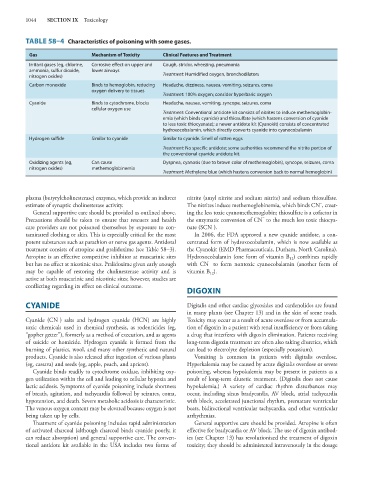Page 1058 - Basic _ Clinical Pharmacology ( PDFDrive )
P. 1058
1044 SECTION IX Toxicology
TABLE 58–4 Characteristics of poisoning with some gases.
Gas Mechanism of Toxicity Clinical Features and Treatment
Irritant gases (eg, chlorine, Corrosive effect on upper and Cough, stridor, wheezing, pneumonia
ammonia, sulfur dioxide, lower airways
nitrogen oxides) Treatment: Humidified oxygen, bronchodilators
Carbon monoxide Binds to hemoglobin, reducing Headache, dizziness, nausea, vomiting, seizures, coma
oxygen delivery to tissues
Treatment: 100% oxygen; consider hyperbaric oxygen
Cyanide Binds to cytochrome, blocks Headache, nausea, vomiting, syncope, seizures, coma
cellular oxygen use
Treatment: Conventional antidote kit consists of nitrites to induce methemoglobin-
emia (which binds cyanide) and thiosulfate (which hastens conversion of cyanide
to less toxic thiocyanate); a newer antidote kit (Cyanokit) consists of concentrated
hydroxocobalamin, which directly converts cyanide into cyanocobalamin
Hydrogen sulfide Similar to cyanide Similar to cyanide. Smell of rotten eggs
Treatment: No specific antidote; some authorities recommend the nitrite portion of
the conventional cyanide antidote kit.
Oxidizing agents (eg, Can cause Dyspnea, cyanosis (due to brown color of methemoglobin), syncope, seizures, coma
nitrogen oxides) methemoglobinemia
Treatment: Methylene blue (which hastens conversion back to normal hemoglobin)
plasma (butyrylcholinesterase) enzymes, which provide an indirect nitrite (amyl nitrite and sodium nitrite) and sodium thiosulfate.
–
estimate of synaptic cholinesterase activity. The nitrites induce methemoglobinemia, which binds CN , creat-
General supportive care should be provided as outlined above. ing the less toxic cyanomethemoglobin; thiosulfate is a cofactor in
–
Precautions should be taken to ensure that rescuers and health the enzymatic conversion of CN to the much less toxic thiocya-
–
care providers are not poisoned themselves by exposure to con- nate (SCN ).
taminated clothing or skin. This is especially critical for the most In 2006, the FDA approved a new cyanide antidote, a con-
potent substances such as parathion or nerve gas agents. Antidotal centrated form of hydroxocobalamin, which is now available as
treatment consists of atropine and pralidoxime (see Table 58–3). the Cyanokit (EMD Pharmaceuticals, Durham, North Carolina).
Atropine is an effective competitive inhibitor at muscarinic sites Hydroxocobalamin (one form of vitamin B ) combines rapidly
12
–
but has no effect at nicotinic sites. Pralidoxime given early enough with CN to form nontoxic cyanocobalamin (another form of
may be capable of restoring the cholinesterase activity and is vitamin B ).
12
active at both muscarinic and nicotinic sites; however, studies are
conflicting regarding its effect on clinical outcome.
DIGOXIN
CYANIDE Digitalis and other cardiac glycosides and cardenolides are found
in many plants (see Chapter 13) and in the skin of some toads.
–
Cyanide (CN ) salts and hydrogen cyanide (HCN) are highly Toxicity may occur as a result of acute overdose or from accumula-
toxic chemicals used in chemical synthesis, as rodenticides (eg, tion of digoxin in a patient with renal insufficiency or from taking
“gopher getter”), formerly as a method of execution, and as agents a drug that interferes with digoxin elimination. Patients receiving
of suicide or homicide. Hydrogen cyanide is formed from the long-term digoxin treatment are often also taking diuretics, which
burning of plastics, wool, and many other synthetic and natural can lead to electrolyte depletion (especially potassium).
products. Cyanide is also released after ingestion of various plants Vomiting is common in patients with digitalis overdose.
(eg, cassava) and seeds (eg, apple, peach, and apricot). Hyperkalemia may be caused by acute digitalis overdose or severe
Cyanide binds readily to cytochrome oxidase, inhibiting oxy- poisoning, whereas hypokalemia may be present in patients as a
gen utilization within the cell and leading to cellular hypoxia and result of long-term diuretic treatment. (Digitalis does not cause
lactic acidosis. Symptoms of cyanide poisoning include shortness hypokalemia.) A variety of cardiac rhythm disturbances may
of breath, agitation, and tachycardia followed by seizures, coma, occur, including sinus bradycardia, AV block, atrial tachycardia
hypotension, and death. Severe metabolic acidosis is characteristic. with block, accelerated junctional rhythm, premature ventricular
The venous oxygen content may be elevated because oxygen is not beats, bidirectional ventricular tachycardia, and other ventricular
being taken up by cells. arrhythmias.
Treatment of cyanide poisoning includes rapid administration General supportive care should be provided. Atropine is often
of activated charcoal (although charcoal binds cyanide poorly, it effective for bradycardia or AV block. The use of digoxin antibod-
can reduce absorption) and general supportive care. The conven- ies (see Chapter 13) has revolutionized the treatment of digoxin
tional antidote kit available in the USA includes two forms of toxicity; they should be administered intravenously in the dosage

